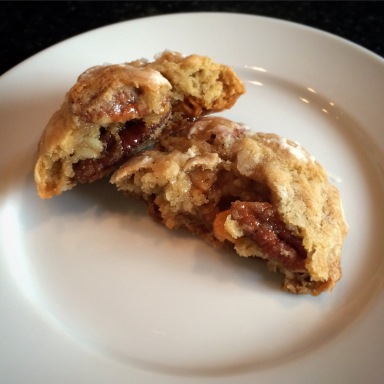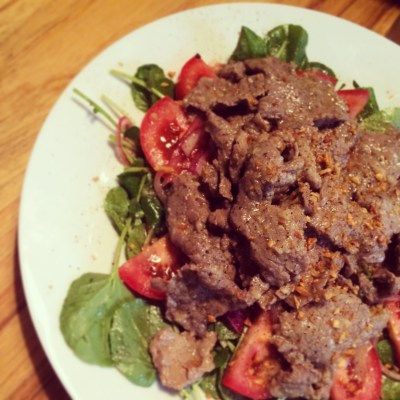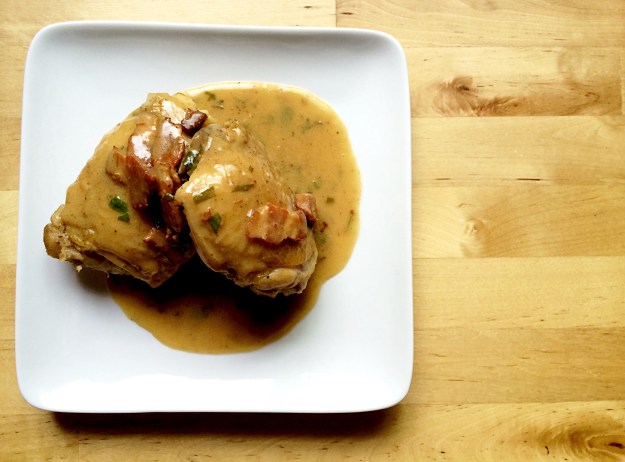Chuc Mung Nam Moi! Happy New Year!
 When I was kid, a large part of my mother’s side of the family lived in Virginia. Our close knit Vietnamese clan would gather with great fanfare for the Lunar New Year. My cousins and I would line up to recite our new year’s wishes in our native tongue to my grandparents. Crossing our arms and bowing, we’d take turns, “Happy New Year! I wish you continued health, happiness and great wealth! May you live a long life!”
When I was kid, a large part of my mother’s side of the family lived in Virginia. Our close knit Vietnamese clan would gather with great fanfare for the Lunar New Year. My cousins and I would line up to recite our new year’s wishes in our native tongue to my grandparents. Crossing our arms and bowing, we’d take turns, “Happy New Year! I wish you continued health, happiness and great wealth! May you live a long life!”
Ba Ngoai, my maternal grandmother, was always dressed in a beautiful silk traditional Vietnamese dress (ai do). Her gray hair pulled back in a neat chignon; her ears adorned with flat, round jade earrings with diamonds in the center. My grandfather, Ong Ngoai, wore a neat, brown wool suit. They sat together on comfortable armchairs in the center of the living room.
My parents, aunts and uncles flanked us with photo and video cameras. They cheered us on when we made our wishes and received our prized lucky red envelope full of money. Occasionally, peals of laughter erupted from the adults when one of us flubbed a word—being second generation, our Vietnamese was, and is, less than stellar—or expanded upon the traditional wish, “… I hope you have great wealth so you can share it with me!”
These warm family gatherings always included mountains of food. One of my favorite Tet (Lunar New Year’s) dishes is Banh Chung, a traditional sticky rice cake filled with mung bean and pork belly, wrapped in banana leaves and cooked. It’s time consuming to make, and seemed to only appear during this time of year. My grandparents made ours in their small apartment kitchen. Ong Ngoia used square wood frames that he’d made himself to shape them. Large pots would boil for hours to cook the square cakes, steaming up their home.
My grandparents lived a long life, as we wished for them. They eventually passed, surrounded by loved ones, and the Banh Chung that they shared with us in my childhood passed with them. So, a couple of years ago, I started to experiment with different recipes I found online. The ingredients are simple: banana leaves, marinated pork, mung bean and sweet rice. I like mine with loads of filling. Most that you can buy are rice heavy. The proportions below reflect my preferences. I like to soak my rice in coconut water. It’s not traditional, but it imparts subtle flavor that complements the banana leaves.
Building the cakes is a little more complicated, so I’ve included step-by-step photos. You’ll find YouTube videos of people free-hand building them. Ha! I tried that; it’s not as easy as it looks. It takes a lot of experience and dexterity to achieve a good looking banh. If your leaves are too soft, the whole thing will fall apart before you can tie it or wrap it together. It may end up looking like a blob. However, I’ve found a good ‘cheat’ that will make your life much easier. I use a square container lined with foil. I hope it helps you as it’s helped me.
Our family has now expanded and scattered across the world, so we no longer have these large gatherings for Tet. But my cousins and I are still very close, and our daily conversations always return to food. Banh Chung is an important topic this time of year: Where will you get yours? Can you send me one that you made? Recipe?
This one goes out to my family, and especially my cousins. Although we’re passing out red envelopes to our own children now, I’m glad that our love of food always keeps our conversations going and our mouths salivating. Chuc mung nam moi! Wishing you wealth, health and happiness, and a belly full of Banh Chung!
Banh Chung
Makes 4
The night before:
- In medium bowl, mix first 4 ingredients together, add pork and marinade overnight
- Rinse rice until water is clear, drain and in large bowl, soak in coconut water overnight
- Rinse mung bean until water is clear and cover with water (water should rise 1″ above beans) in large bowl to soak overnight
- Clean banana leaves by soaking and rinsing
- Cut a letter size sheet of paper down to 8.5″x8.5″ to make template
- Using scissors make 16 pieces (you’ll need 4 of these for each cake) of 8.5″ x 8.5″ banana leaves. Fold them down to 4.25″ square. Cut and additional four 3″ banana leaves squares. Dry with paper towels, wrap or store in plastic bag and refrigerate until ready to use.
Assembly
- Drain rice completely and mix with salt and divide into 4 portions.
- Drain mung bean and divide in to 4 portions
- Divide pork into 4 portions, setting aside leftover marinade for use
- Cut eight 18″ long pieces of aluminum foil
- Line a 4″x4″ or a little bigger square cake pan or container (I use a square glass Pyrex style) container with a sheet of foil, lenght-wise
- Unfold a banana leaf square and refold into a box corner like so:


- Insert into foiled lined mold, lining piece up with corner:

- Repeat for each corner until you’ve created a box. Pictured here with 2 corners:

- Fill the bottom of the banana leaf box with 1/3 of 1 portion of the rice and push the rice with a spoon to the side to make a 1/4-1/2″ lip, while maintaining rice at the bottom to make an inset for mung beans:

- Put 1/2 of one portion of mung bean on top of rice, leaving 1/4″-1/2″ around the edges
- Top with portioned pork and 1/4 of leftover marinade (marinade and pork fat will help to flavor the mung beans):

- Fill edges with 1/3 of portioned rice, scooting the rice with a spoon to make a little well around pork for mung beans:
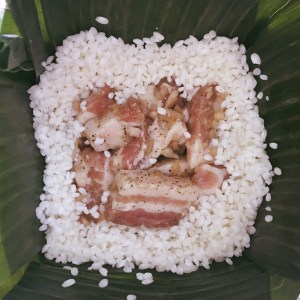
- Fill well and top pork with the other half of the mung bean, leaving a 1/2″ around beans for rice:

- Fill edges with rice and cover mung bean with remainder of rice:

- Top with a piece of the square leaf:
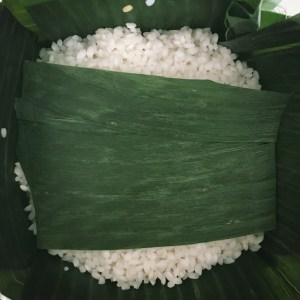
- Fold in edges of banana leaf box and tightly fold foil over:

- Invert over another sheet of foil and wrap tightly:
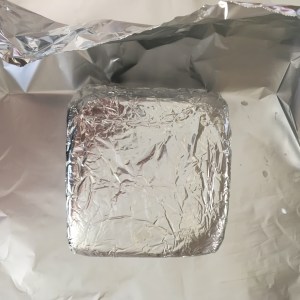
- Tie cakes together with kitchen twine, string wrapped around once on each side (like a gift)
- When all cakes are made, cover as many as will fit in your pot with water in your Instant Pot or traditional pressure cooker
- For Instant pot cook on high pressure for 1 hour 30 minutes and keep warm (natural release) for another 1 hour 30 minutes.
For pressure cooker, follow instructions to secure cover and bring to highest pressure. Over the lowest heat on your stove to maintain pressure, cook for 2 hours and 10 minutes - Follow manufacturer instructions to release pressure from your Instant Pot or traditional pressure cooker
- Pull cakes out with tongs, letting them drain for a minute and set on rimmed cookie sheets to cool for 2 hours
- Unfoil and tightly wrap with Saran wrap, patting cakes back into square shape. Refrigerate until ready to serve
To serve banana leaves are removed and typically cakes are sliced and pan fried in a little oil (right photo) and served with Vietnamese pickled vegetables and a little fish sauce to dip. We’ve been known to eat them warm, an hour after cooling (left photo). Not very traditional, as the cake doesn’t hold it’s shape, but we love the soft, almost gooey tender rice and fall-apart fatty pork and the soft savory mung beans.
Lastly, a tip from my mother: wrap your knife in a layer of plastic wrap when cutting. Your slices will come out sharply cut and your knife easy to clean. Enjoy!




